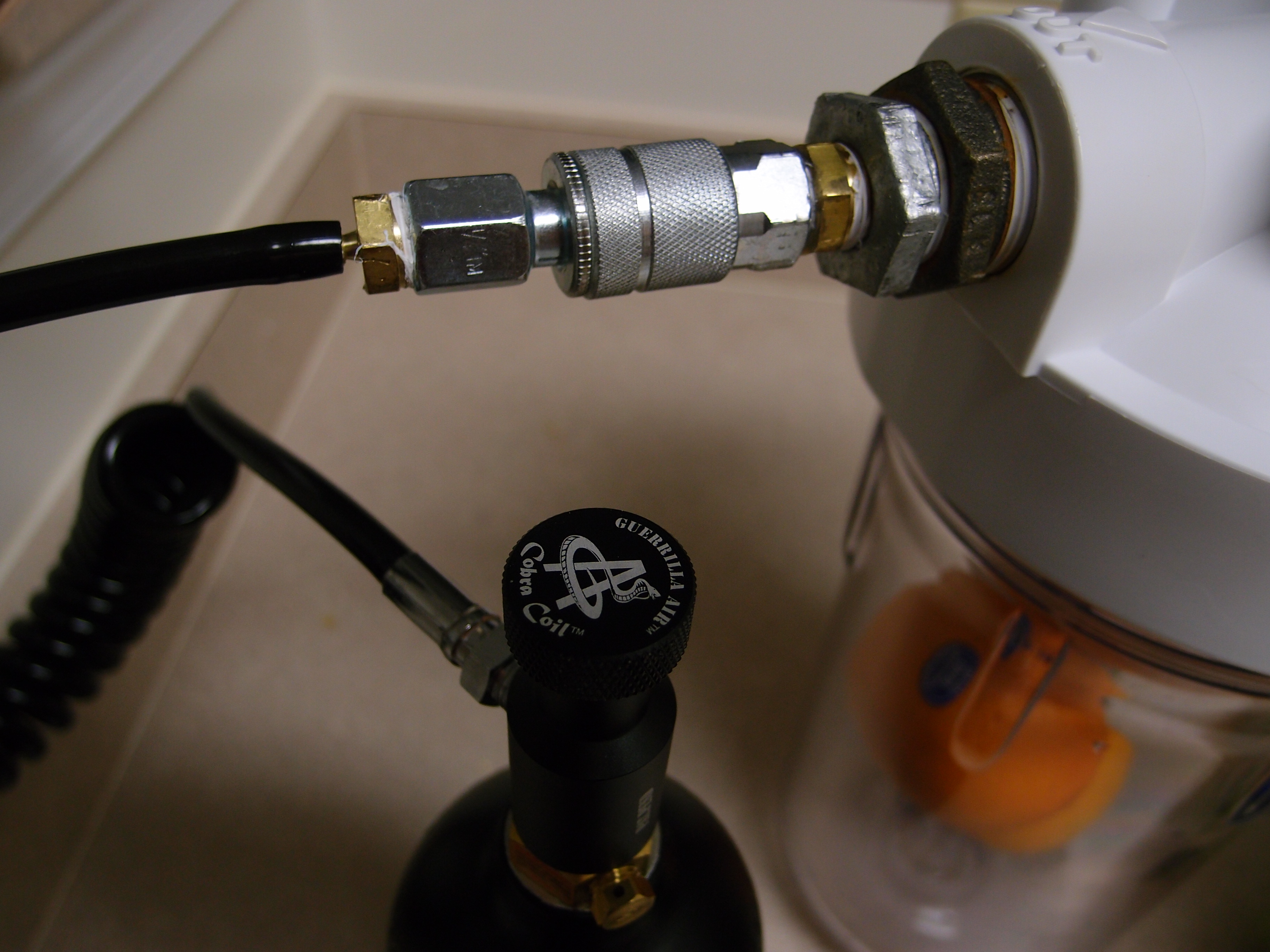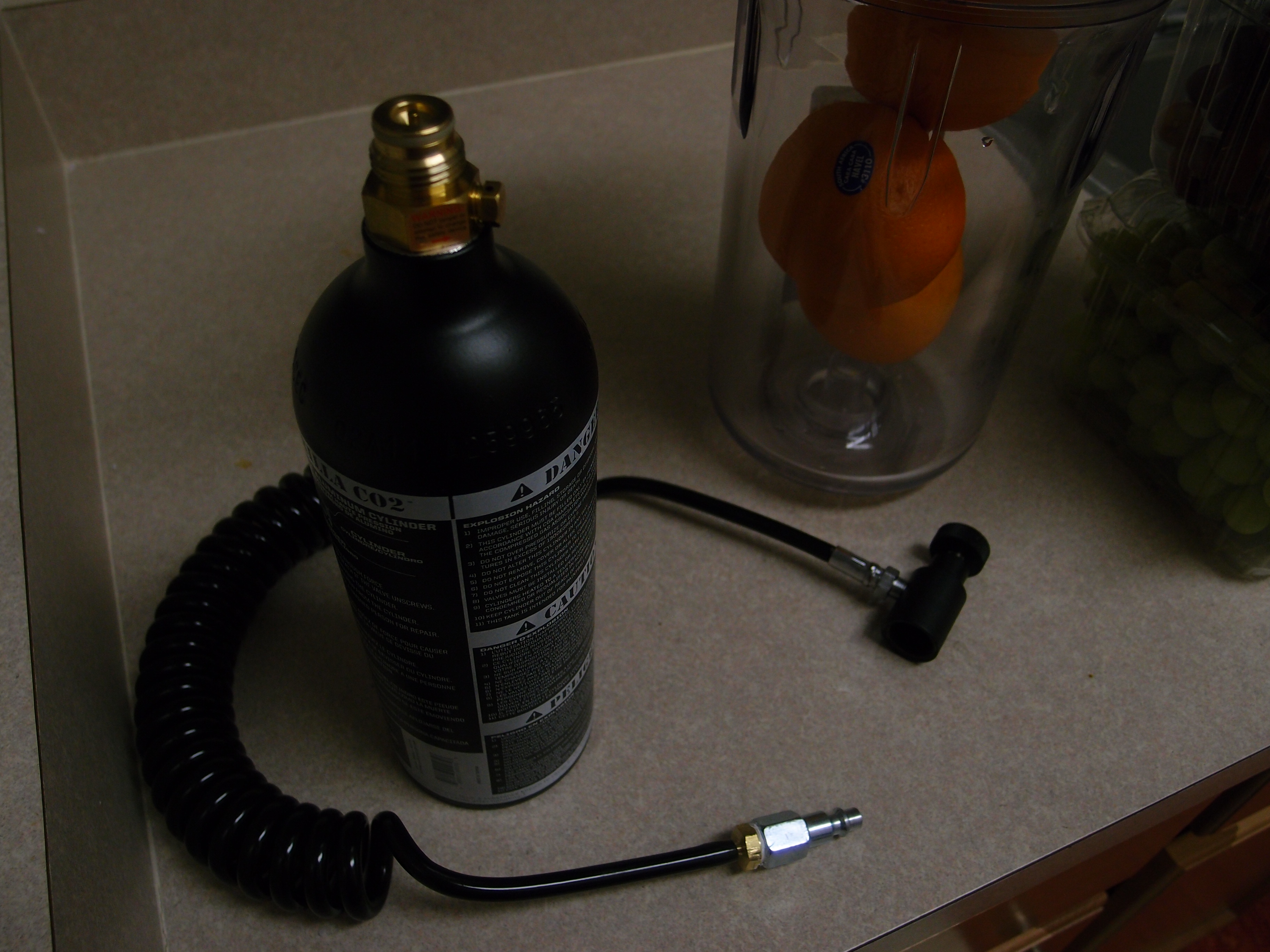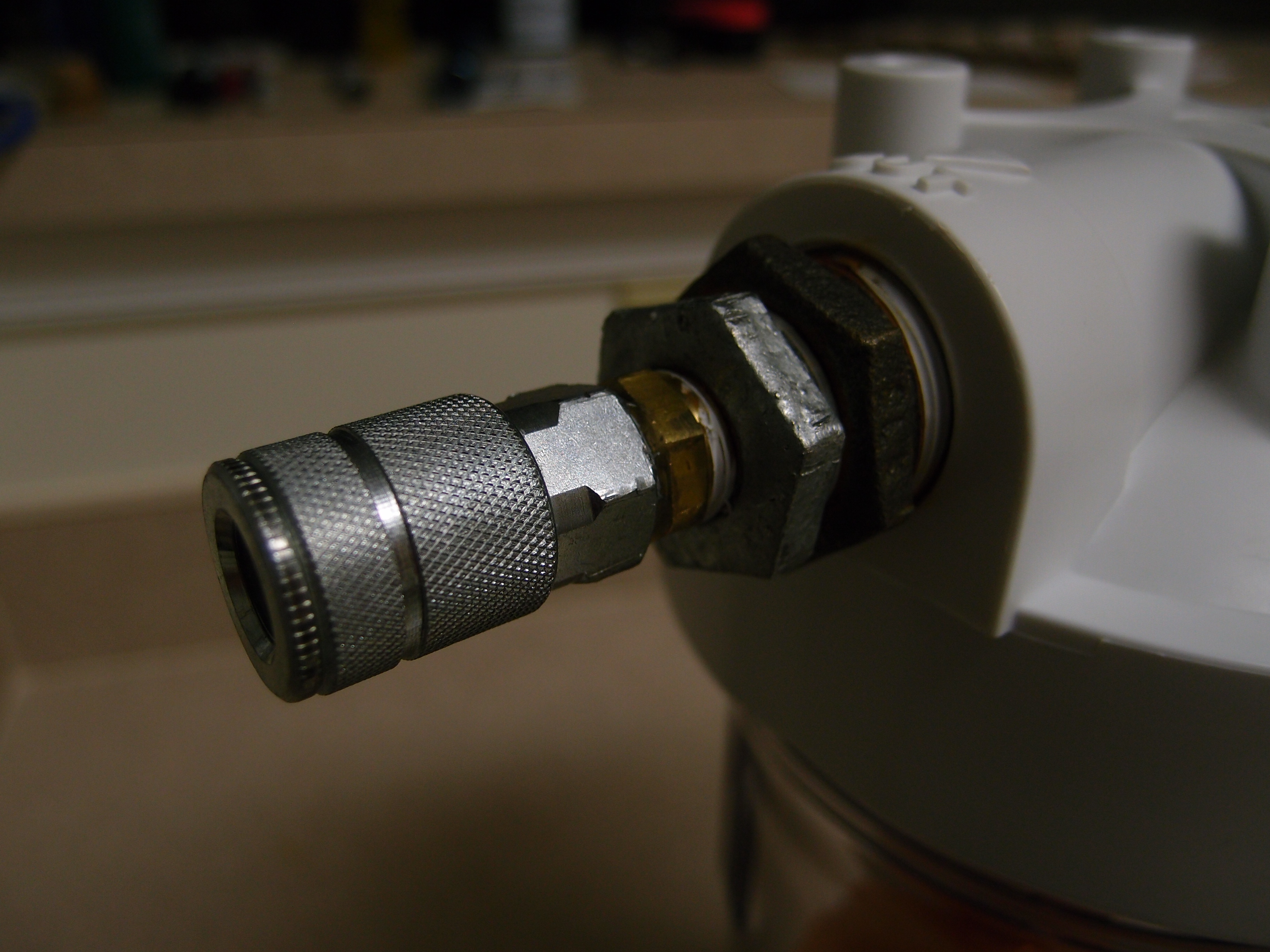DIY Carbonator

This short instructable will show you how to make a carbonating tank. This is useful if you want to make your own soda, maybe you like fizzy coffee, or making fizzy fruit. The principle is simple. Water can absorb carbon dioxide (CO2) if they are both pressurized together. The colder the water (ice is not water, so not freezing temperatures) the more CO2 it will absorb. When the pressure is released the CO2 will start to escape from the water and creates a fizzing action just like your favorite bottle of root beer (it's Virgils...only try it if you're willing to be addicted).
Our DIY carbonator is going to be very simple. We just need a tank to store our carbonating target that is capable of being pressurized to about 100 PSI. Rich Faulhaber over at Evil Mad Scientist Labs was nice enough to share the idea of using a water filter housing. Check out www.evilmadscientist.com/article.php/co2inator to see how he did it. Follow on to the next steps to see my take on it.
Our DIY carbonator is going to be very simple. We just need a tank to store our carbonating target that is capable of being pressurized to about 100 PSI. Rich Faulhaber over at Evil Mad Scientist Labs was nice enough to share the idea of using a water filter housing. Check out www.evilmadscientist.com/article.php/co2inator to see how he did it. Follow on to the next steps to see my take on it.
The CO2 Tank



You can build all the carbonating vessels you want, but you can't carbonate anything without some CO2. Thanks to the popularity of paint ball, you can easily get a small CO2 tank and CO2. Just look up your local paint ball equipment supplier and buy a tank from them. The 20 oz tank I bought cost $25 and the "remote supply line" was $30.
The remote supply line makes this setup easy. One side screws onto the tank and the other usually has a quick connect system. I couldn't find fittings that would adapt the quick connect to the plumbing fittings on the water filter housing, so I just cut the paintball quick connect fastener off. With that out of the way, just use a barb fitting and a standard air compressor quick connect fitting to make things work with the water filter housing.
Be sure to use teflon tape on the threads of all connections to prevent leaks!
The remote supply line makes this setup easy. One side screws onto the tank and the other usually has a quick connect system. I couldn't find fittings that would adapt the quick connect to the plumbing fittings on the water filter housing, so I just cut the paintball quick connect fastener off. With that out of the way, just use a barb fitting and a standard air compressor quick connect fitting to make things work with the water filter housing.
Be sure to use teflon tape on the threads of all connections to prevent leaks!
The Pressure Vessel


The pressure vessel is the most expensive part of this build. There are many kinds of water filters; for refrigerators, water bottles, etc. The type you want is a "whole house" water filter. I bought mine from Lowes and it is a Whirlpool brand. I like the Whirlpool because they have a clear filter housing. There are many different sizes...the big one I bought holds two grapefruits and three oranges easily (after they are peeled). The down side is that it costs about $65.
Different filter housings have different connections, so this next part is going to be a bit vague. You need to find a way to plug one side of the filter housing and convert the other to the air compressor quick connect. For my filter housing it took the following fittings:
1 - 1" to 3/4" adapter
1 - 3/4" to 3/8" adapter
1 - 3/8" to 1/4" adapter
1 - air compressor quick connect recpticle
1 - 1" plug fitting
In the pictures you can see that I have some steel connectors and adapters, which is bad. You should only use brass fittings to prevent corrosion.
Another important addition to what you see in the pictures would be a pressure gauge. It would be easy to attach a pressure gauge to the plugged side of the water filter housing. Without the pressure gauge you don't know if you're over-pressurizing the housing, which is very dangerous. Be safe and get a pressure gauge!
Different filter housings have different connections, so this next part is going to be a bit vague. You need to find a way to plug one side of the filter housing and convert the other to the air compressor quick connect. For my filter housing it took the following fittings:
1 - 1" to 3/4" adapter
1 - 3/4" to 3/8" adapter
1 - 3/8" to 1/4" adapter
1 - air compressor quick connect recpticle
1 - 1" plug fitting
In the pictures you can see that I have some steel connectors and adapters, which is bad. You should only use brass fittings to prevent corrosion.
Another important addition to what you see in the pictures would be a pressure gauge. It would be easy to attach a pressure gauge to the plugged side of the water filter housing. Without the pressure gauge you don't know if you're over-pressurizing the housing, which is very dangerous. Be safe and get a pressure gauge!
Using the Carbonator

Once you have it all put together, just put whatever you want to carbonate inside and then pressurize it with CO2. You can experiment with different CO2 pressures, different storage temperatures, and lengths of time it stays pressurized. In my tests with fruit I've found that you want at least 50 PSI and put it in the fridge for at least 1 hour. Once you open the pressure vessel you have about 30 minutes before the fruit isn't carbonated anymore.
If your pressure vessel is clear like mine you can see a lesson that every deep sea diver knows well. The bends, decompression sickness, divers' disease, caisson disease, whatever you want to call it, it's bad news. If you release the pressure from your system too fast the skin of your fruit will break open and bubbles will squirt out everywhere. The rapid release of pressure is more than the fruit can take. This is the same thing that happens to a diver's body if they surface from the bottom of the ocean too fast. The pressurized nitrogen in their body tries to escape any way it can, and that usually is through the blood vessels. Unlike a diver, your fruit will still be useful after suffering from the bends. It will just make a big mess inside the pressure vessel.
That's all there is to the DIY carbonator. I've filled my pressure vessel 5 times and still haven't ran out of CO2, so a 20 oz tank of CO2 can get you through lots of parties or curious children. Please be very careful when working with pressurized gasses and foods. Make sure your equipment is clean and free of oils, debris, metal shavings, and other harmful items. Use a pressure regulator or at least a pressure gauge to make sure you don't over-pressurize the water filter housing, 100 PSI is more than enough to carbonate anything this type of pressure vessel can handle. Be safe and have fun!
If your pressure vessel is clear like mine you can see a lesson that every deep sea diver knows well. The bends, decompression sickness, divers' disease, caisson disease, whatever you want to call it, it's bad news. If you release the pressure from your system too fast the skin of your fruit will break open and bubbles will squirt out everywhere. The rapid release of pressure is more than the fruit can take. This is the same thing that happens to a diver's body if they surface from the bottom of the ocean too fast. The pressurized nitrogen in their body tries to escape any way it can, and that usually is through the blood vessels. Unlike a diver, your fruit will still be useful after suffering from the bends. It will just make a big mess inside the pressure vessel.
That's all there is to the DIY carbonator. I've filled my pressure vessel 5 times and still haven't ran out of CO2, so a 20 oz tank of CO2 can get you through lots of parties or curious children. Please be very careful when working with pressurized gasses and foods. Make sure your equipment is clean and free of oils, debris, metal shavings, and other harmful items. Use a pressure regulator or at least a pressure gauge to make sure you don't over-pressurize the water filter housing, 100 PSI is more than enough to carbonate anything this type of pressure vessel can handle. Be safe and have fun!